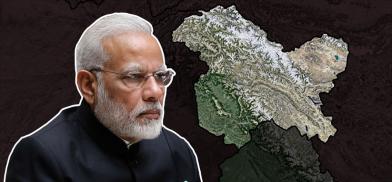How sacrosanct is the 'Idea of India'?
Experts are divided about the legality and constitutional propriety of the August 5 decisions in relation to Article 3 and the reorganization of states. What is at stake is the sanctity of constitutionalism and for PM Narendra Modi the way the Kashmir issue unfolds will define his political legacy, writes C Uday Bhaskar for South Asia Monitor

Reviewing the performance of his government after 75 days in office, Prime Minister Narendra Modi asserted that there was no bigger decision than the one on Kashmir. There is no hyperbole in this claim. August 5, 2019 will be long remembered in the annals of Indian political history as a day when the government of the day took a VERY bold and radical decision to dilute the provisions of Article 370 of the Constitution of India that had accorded a special status to the state of Jammu and Kashmir (J&K) ; and furthermore, bifurcated the long troubled state into two separate union territories.
Repealing Article 370 has been a long held political objective of the Hindu right-wing since this was added to the constitution as a temporary provision in November 1952. Relying on its parliamentary majority, the Modi government chose to bite this bullet with remarkable success. Shepherded by Home Minster Amit Shah, the August 5 decisions left Kashmir in shock – that from being the centre of power in a composite state it had been reduced to one part of a union territory – and this was effected by an innovative interpretation of Article 370.
The deed is done and it has been hailed by team Modi and its support base as a decisive triumph that has corrected the errors of history (read Nehru’s follies). The more tangible outcome is that by end October India will have a new political map but a populace in Kashmir valley that will feel even more alienated than they did prior to August 5.
However, the more intangible outcome of the August 5 decision is the manner in which it will negatively impact the democratic ethos of India and its standing as the world’s largest liberal democracy ostensibly committed to its Constitution. Yes there were transgressions, the most infamous being the imposition of the Emergency by then Prime Minister Indira Gandhi in June 1975.
A strong-willed leader took what was deemed to be a ‘bold’ decision and finally it took the Indian judiciary to bring the executive back to the normative constitutional track. The Emergency case was referred to the Supreme Court (SC) of India in December 1975 and while the majority supported the government decision, one lone voice dissented in what is celebrated as the Habeas Corpus case. Justice H R Khanna dissented and noted famously: “The Constitution and the laws of India do not permit life and liberty to be at the mercy of the absolute power of the Executive . What is at stake is the rule of law. The question is whether the law speaking through the authority of the court shall be absolutely silenced and rendered mute.”
While this brave and courageous stand cost him the top position of Chief Justice of India (Indira Gandhi denied this to him when she came back to office) Justice Khanna is still remembered by India and the world as the one voice that saved Indian democracy.
In the present Article 370 case, the matter has been referred to the courts and the SC (August 13) declined to pass any orders on a plea challenging the government’s decision to impose restrictions and “other regressive measures” in Jammu and Kashmir. The more fundamental issue challenging the legality of the August 5 decision filed by the National Conference is likely to be taken up in the course of the year.
Experts are divided about the legality and constitutional propriety of the August 5 decisions in relation to Article 3 and the reorganization of states. What is at stake is the sanctity of constitutionalism and for PM Narendra Modi the way the Kashmir issue unfolds will define his political legacy. At the core is the extreme Hindu political ideology that harks back to the Indian freedom movement that would like to recast India as a Hindu nation-state. The fact that the Gandhi-Nehru combine prevailed has given India its current secular contour and the state remained committed to respecting and protecting diversity. It merits recall that the word ‘secular’ was added to the Preamble of the Constitution in 1976 through the 42nd amendment.
Will the Modi-Shah effort change the very 'Idea of India' ? We can benefit from the observations of another eminent judge Justice Ruma Pal who noted: “ The framers of the Constitution wanted to ensure the perpetuation of the ‘one-nation’ doctrine to distinguish it from the theocratic state of Pakistan and to reassure the minorities i) that Parliament would not only not impose any religion but would also ensure freedom of religion amongst all Indian people and ii) that all religious communities would be treated equally.”
Earlier in 1975, Justice Khanna also added that “Although the words ‘secular state’ are not expressly mentioned in the Constitution, there can be no doubt that our Constitution-makers wanted establishment of such a state. The provisions of the Constitution were designed accordingly. There is no mysticism in the secular character. Secularism is neither anti-God, nor pro-God, it treats alike the devout, the agnostic and the atheist. It eliminates God from the matters of the state and ensures that no one shall, be discriminated against on the ground of religion.”
The tricolour epitomizes the sanctity of a freedom attained on August 15 , 1947 and this was enshrined later in the Constitution wherein all citizens were deemed to be equal. Will this cardinal principle be protected as per the letter and spirit of the Constitution ? All eyes will be on PM Modi when he unfurls the flag on Thursday.
(The author is Director, Society for Policy Studies, New Delhi)









Post a Comment